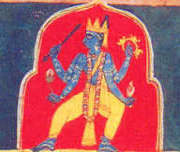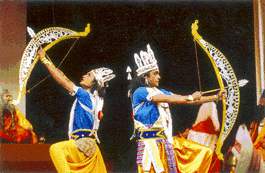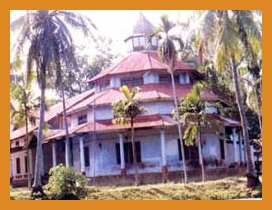Introduction to Sankaradeva’s Eka Sarana Faith and Movement

[For a very short introduction, see this article.]
The closing decades of the 15th century in Assam witnessed the rise of a unique school of pure devotion to Krsna that also assumed the nature of a movement for social reform. In the face of insurmountable odds, SankaradevaSankaradeva refers to himself in his own writings as “Sankara.” The honorific “deva,” pertaining to “divinity” or “Lord” was suffixed to the name of this extraordinary personality by the scholars and the later key personalities of the Eka Sarana school, beginning with Madhavadeva in his Guru Bhatima (ki kahaba śaṅkara, devara mahimā). It seems not only to be a tribute to the extraordinary prowess of Sankaradeva in his role as the reclaimer and propagator of Eka Sarana but also seems to be firmly established in the Bhagavata tradition of viewing the guru giving the knowledge of pure devotion to the Lord as the Lord himself (see Bhakti Ratnakara, first chapter).
The epithets “Srimanta” and “Mahapurusa,” either jointly or singly, are also found applied to the name of Sankaradeva as in “Mahapurusa Srimanta Sankaradeva” (IAST: Mahāpuruṣa Śrīmanta Śaṅkaradeva; AS: মহাপুৰুষ শ্ৰীমন্ত শঙ্কৰদেৱ). The term “Srimanta”—which could mean “splendorous,” “graceful” or “endowed with opulence”—seems to have been first applied by Madhavadeva in his Nama Ghosa (śrīmanta śaṅkara mata (v. 33), śrīmanta śaṅkare, pāra bhāṅi dilā (v. 371), śrīmanta śaṅkara, hari bhakatara (v. 375), parama kṛpālu, śrīmanta śaṅkare (v. 404), śrīmanta śaṅkare prakāśilā (v. 625), śrīmanta śaṅkare bhāṅgilā (v. 669)).
The epithet “Mahapurusa” also is not of the modern period. Gopalacarana Dvija, in his rendering of the Bhakti Ratnakara of Sankaradeva into Assamese prose, uses the words: santasūryya mahāpuruṣa śrīśaṅkarara kena kṛpāguṇa. While it could have a (secondary) meaning of “great or eminent man,” in the context of the philosophy of Sankaradeva—which deals with the supreme purusa—it seems more appropriate to regard it in its superior and higher meaning of “supreme spiritual personality.” Its application in this sense would reflect the philosophy of the guru outlined above.
(IAST: Śaṅkaradeva
The name of Sankaradeva is also found transliterated in various writings as “Sankardeva,” “Sankardev,” “Shankar Dev,” etc.
; AS: শঙ্কৰদেৱ), a spiritual and social reformer and a versatile figure, propagated a religion There are today literally millions of followers of different shades of Sankaradeva’s religion all across Assam. However it must be kept in mind that many of these forms of the religion of Sankara seem very likely to be mere approximations of the original Eka Sarana faith (preached by Sankaradeva in his own time). known as eka śaraṇa hari nāma or “the doing of pure devotion“Nama” refers to “pure devotion;” it consists primarily in singing (kirttana) and listening to (sravana) the “deeds” and “activities” of Krsna (God—specifically, in his immanent capacity). Sankaradeva, in his works, has extolled these two forms of doing devotion to the Lord. However, it (“nama”) also implies the discarding of a certain material philosophy (see footnote to “bhaktic” below) and it is to indicate this aspect that we have qualified “devotion” with “pure” in our translation. “Eka sarana” means “sole-refuge” and “hari” is Krsna.
to God taking sole-refuge in him,” which, on superficial glance, might appear similar to the other vaisnava movements that took root in the India of the same time. But the great characteristic that marked the rise of this new school was its insistence on basing its theology on a purely bhaktic
“Bhaktic” here relates to “pure devotion.” The bhaktic philosophy of Sankaradeva is one that steers clear of all microcosmic emulations technically referred to as “karma.” Here, the individual personalities are considered to be minuscule parts (amsas), as it were, of God, the supreme spiritual personality and, being ontologically superior to primal matter, owe no allegiance to “her” or to her evolutes, “gods” and “goddesses” included. The “dharmic” (not to be confused with “righteousness”) philosophy, on the other hand, conceives of men as material personalities and as amsas of primal matter—to put it more precisely, as parts of the body of purusa. On the practical side, it consists in the doing of certain “ordained-duties” (karmas) which, basically, are emulations that imitate the working of the neural entities within the human body (the microcosm). [For a discussion on this microcosmic basis, see this article.]
Sankaradeva’s religion does not operate within the karmic (dharmic) context. It is purely bhaktic in nature. There is one word used to describe the Eka Sarana religion of Sankara in its practical manifestation and that is “bhajana”—pure devotion, untrammeled by karma. It is, technically speaking, not Vaisnavism which operates within the bounds of the karmic philosophy—“sruti” and “smrti,” as mentioned by Madhavadeva in his Nama Ghosa (v. 628).
philosophy rather than the conventional dharmic one.As a result, it came into direct conflict with the ruler-sacerdotalist nexus and the extreme brutality of the persecution which it faced at the instance of the dharmic orthodoxy is perhaps matched only by the cruelties inflicted on the followers of the early Christian faith by the Roman authorities.





| Propagator of | Eka Sarana |
| Philosophy | Mahapurusism |
| Foremost Disciple | Madhavadeva |
| Major Works | Kirttana, Bhagavata renderings, Bhakti Ratnakara, Bhakti Pradipa |
| Language | Assamese, Vrajawali, Sanskrit |
| Cultural Creations | Baragita, Ankiya Nata |
| Architectural Innovations | Nama-ghara |
It followed the Bhagavata Purana, which is famous for espousing the message of pure Vedantic bhakti, as its canonical text. To a beginner, the most apt picture to conjure up in one’s mind regarding this pure bhakti would be perhaps that of a system like Kabir’s fused with the intense flow of the juice (rasa) of love for God. This is also known as rasamaya bhakti or “nectar-flavored” devotionThe term “rasamaya bhakti” or “nectar-flavored” devotion is used by Madhavadeva, the most beloved student of Sankaradeva, in the very first verse of his Nama Ghosa, a work celebrated among the adherents of the Eka Sarana faith.—exclusive, pure, love-for-love’s-sake, indifferent even to liberation (mukti).

 Sankaradeva was a very versatile personality. During his entire lifetime, he concentrated his energies on bringing home to the lay populace the message of the Vedantic-Puranic system through diverse media that made easy the comprehension of the philosophico-scientific truths contained in the primary texts. The story (kāhinī) of Krsna in Sankaradeva is not one of an “epic hero” or historical personality of ancient IndiaOne very eye-catching feature of the Sankaradeva movement is that there never has been a centrality of an external geographic conception of a Mathura or a Gokula in the lives of its saints and leading personalities. but, rather, the “story” of the supreme immanent personality (paramātmā) within the microcosm—the human body—actuating the senses and the (material) organic entities for the sake of sustaining the life of the embodied personality (jīva) who really is a pure personality (puruṣa)—an entity belonging to the same ontological category as God—but, now, due to non-devotion to the Lord, has fallen into matter (prakṛti) and become dead and extremely matter-like (jaḍa). It is the immanent conception of God; and this intense “paramatmic” flavor which the reader savors in all of the Sankaradeva-ite literatureAmong all the works of the Eka Sarana school this paramatmic spirit is perhaps best reflected in the Nama Ghosa (The Proclamation of Pure Devotion) of Madhavadeva. is also reflected in the praxis of the adherents of the faith. And it is a great reason why the Eka Sarana faith distinguishes itself from the conventional stream of Vaisnavism. About this paramatmic basis of Sankaradeva, we will have more to say in a later section.
Sankaradeva was a very versatile personality. During his entire lifetime, he concentrated his energies on bringing home to the lay populace the message of the Vedantic-Puranic system through diverse media that made easy the comprehension of the philosophico-scientific truths contained in the primary texts. The story (kāhinī) of Krsna in Sankaradeva is not one of an “epic hero” or historical personality of ancient IndiaOne very eye-catching feature of the Sankaradeva movement is that there never has been a centrality of an external geographic conception of a Mathura or a Gokula in the lives of its saints and leading personalities. but, rather, the “story” of the supreme immanent personality (paramātmā) within the microcosm—the human body—actuating the senses and the (material) organic entities for the sake of sustaining the life of the embodied personality (jīva) who really is a pure personality (puruṣa)—an entity belonging to the same ontological category as God—but, now, due to non-devotion to the Lord, has fallen into matter (prakṛti) and become dead and extremely matter-like (jaḍa). It is the immanent conception of God; and this intense “paramatmic” flavor which the reader savors in all of the Sankaradeva-ite literatureAmong all the works of the Eka Sarana school this paramatmic spirit is perhaps best reflected in the Nama Ghosa (The Proclamation of Pure Devotion) of Madhavadeva. is also reflected in the praxis of the adherents of the faith. And it is a great reason why the Eka Sarana faith distinguishes itself from the conventional stream of Vaisnavism. About this paramatmic basis of Sankaradeva, we will have more to say in a later section.
 He wrote trendsetting popular plays, composed songs of the devotional genre set to classical ragas as well as numerous devotional poems (kīrttanas) for congregational singing and even got built spacious prayer houses for the masses to pray together in a whole-souled manner, in front of the text of the Bhagavata. His movement was a potent force for the development of the art of manuscript illustration and painting.
As a result of all these, there was a sort of distillation of the essence of the Vedanta in the vernacular language, essentially Assamese of the older variety, and Vrajawali which, like the Hindi of today, could have been the then lingua franca (although Sankaradeva did author in Sanskrit a highly influential text known as the Bhakti Ratnakara).
He wrote trendsetting popular plays, composed songs of the devotional genre set to classical ragas as well as numerous devotional poems (kīrttanas) for congregational singing and even got built spacious prayer houses for the masses to pray together in a whole-souled manner, in front of the text of the Bhagavata. His movement was a potent force for the development of the art of manuscript illustration and painting.
As a result of all these, there was a sort of distillation of the essence of the Vedanta in the vernacular language, essentially Assamese of the older variety, and Vrajawali which, like the Hindi of today, could have been the then lingua franca (although Sankaradeva did author in Sanskrit a highly influential text known as the Bhakti Ratnakara).




Madhavadeva, his foremost disciple, has described him as a “mine of all good qualities.” He has brought down the “river of the nectar of the love of God” from Vaikuntha, the transcendental society. In fact, so deep is the impact of Sankaradeva on the spiritual and also social—there being, in this context, an intimate connection between the two—landscape of Assam that the entire corpus of medieval Assamese bhakti literature is resonant with his praise.
 Paralleling this spiritual reform was a strong surge of social reform which swept away the dharmic conception of society and sought to remodel society on bhaktic lines. This made the preaching of the eka sarana faith also very much a social movement. In the modern period, some scholars have glossed over this important social angle. In their view, Sankaradeva sought merely to establish equality for all on the spiritual plane without seeking to disturb the status quo in the social order. This is a mistake of epic proportions.
Paralleling this spiritual reform was a strong surge of social reform which swept away the dharmic conception of society and sought to remodel society on bhaktic lines. This made the preaching of the eka sarana faith also very much a social movement. In the modern period, some scholars have glossed over this important social angle. In their view, Sankaradeva sought merely to establish equality for all on the spiritual plane without seeking to disturb the status quo in the social order. This is a mistake of epic proportions.
The society in Sankaradeva’s time was organized into a hierarchy on the basis of a system of varṇa and āśrama which laid down separate duties (dharmas) for the different categories and castes. This was essentially born of a philosophy of bheda or intrinsic difference which saw man as a part of matter rather than as a spiritual personality and sought to emulate the material units of the microcosm. However, Sankaradeva’s philosophy, which runs counter to such a philosophy of difference, is that of intrinsic equality. In fact, the very doing of pure devotion is predicated on the existence of a transcendental society in which all members are essentially of one kind. All are puruṣas or pure personalities; they are by nature immutable and hence not subject to placement at different levels on a material scale. Therefore the bhaktic philosophy envisages a kind of society which is modeled on Vaikuntha, the transcendental society, in which the governing ideal is one of equality. The embracing of such a philosophy by Sankaradeva and its widespread dissemination among the masses automatically put the conception of the dharmic society at peril and in threat of diminution, if not eventual extinction.
Top ↑Editor’s Notes
This article is a reproduction of Sankaradeva’s Eka-Sarana Faith and Movement written by Arunava Gupta. It is available on his blog eka-sarana.blogspot.com.
References (Resources Utilized in Making this Page)
The following resources were used in making this page:-
- Gupta, Arunava. “Sankaradeva’s Eka-Sarana Faith and Movement.” Sankaradeva’s Eka-Sarana Hari-Nama Dharma, eka-sarana.blogspot.com/p/blog-page.html.